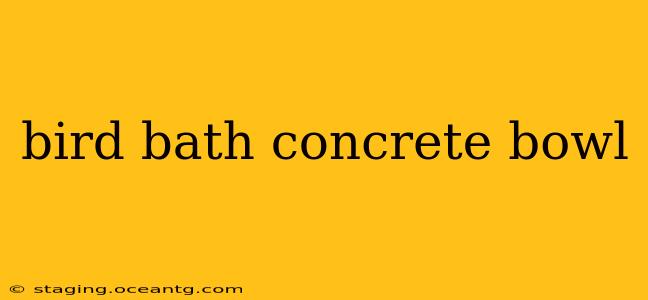For bird lovers, a bird bath is more than just a decorative element; it's a vital lifeline for feathered friends, offering a much-needed source of hydration and bathing opportunities. A concrete bird bath bowl, in particular, offers durability and a rustic charm that complements many garden styles. This guide will delve into everything you need to know about concrete bird baths, from choosing the right one to crafting your own and ensuring its longevity.
What are the benefits of a concrete bird bath bowl?
Concrete bird baths offer several advantages over their plastic or ceramic counterparts. Their robust nature makes them highly resistant to cracking and chipping, even with frequent use and exposure to the elements. They are also heavier, making them less likely to tip over in windy conditions. Finally, their natural, often textured surface provides birds with a secure footing, reducing the risk of slips and falls.
What size concrete bird bath bowl should I get?
The ideal size depends on the number and size of birds you anticipate using it. A larger bowl naturally accommodates more birds simultaneously. However, a shallower bowl might be preferred for smaller birds, reducing the risk of drowning. Consider your garden space as well. A small garden might look crowded with a very large concrete bird bath.
How deep should a concrete bird bath be?
How deep should the water be in a concrete bird bath? This is crucial for bird safety. The water should be shallow enough for birds to easily reach the bottom, typically no more than 1-2 inches deep. Deeper water poses a drowning risk, especially for smaller species. You can achieve this with a sloped bowl design or by placing rocks in the bottom for birds to perch on.
How do I clean a concrete bird bath bowl?
Regular cleaning is crucial to prevent the spread of diseases among birds. At least once a week (more frequently in warm, humid weather), empty the bowl and scrub it thoroughly with a brush and mild soap, rinsing it well with clean water. Avoid using harsh chemicals, as these can be harmful to birds.
Can I make my own concrete bird bath bowl?
Absolutely! Creating your own concrete bird bath bowl is a rewarding DIY project. You can find numerous tutorials online detailing different techniques and designs. The process generally involves mixing concrete, pouring it into a mold (such as a suitably sized bowl or a purpose-built form), and allowing it to cure for several days before removing the mold and adding any finishing touches. Remember to use a non-toxic concrete mix suitable for outdoor use.
What kind of concrete is best for a bird bath?
Using a high-quality concrete mix is key to the longevity of your bird bath. Look for a pre-mixed concrete designed for outdoor projects that is both durable and resistant to cracking.
How do I prevent algae growth in my concrete bird bath?
Algae can quickly become a problem in bird baths, especially in areas with abundant sunlight. Regularly cleaning the bowl, as mentioned earlier, helps, but you can also consider using a mixture of white vinegar and water to scrub the bowl occasionally. Avoid using harsh chemicals that could harm birds. Adding a small amount of bleach to the water (following appropriate dilution guidelines) can also help prevent algae growth but should be done infrequently to prevent harming the birds.
How do I keep my concrete bird bath from freezing in winter?
In freezing climates, the water in your concrete bird bath can freeze, potentially causing cracks in the bowl or posing a danger to birds who may try to drink from it. Using a heated bird bath element can prevent freezing, or simply bringing the bird bath indoors during particularly cold snaps can protect both the bird bath and visiting birds.
By following these guidelines, you can enjoy the beauty and functionality of a concrete bird bath bowl for years to come, providing a welcome oasis for your feathered friends. Remember that maintaining your bird bath is crucial for their safety and well-being.
